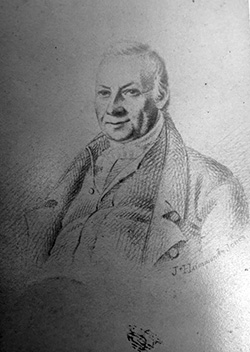The Rev. Lewis EVANS FRS 1753 - 1827
Sixth child, fourth son of The Rev. Thomas EVANS (1716 – 1774) of Basseleg, Monmouthshire and Jane née JONES (1717- 1783)
Born 1753 Llywell, Brecon
Died 1827 Froxfield, Wiltshire
He married twice.
By his first wife, Ann NORMAN (1753 – 1788) m. 16 May 1776, he was father of
1. Thomas Simpson EVANS 1777 - 28 Oct 1818
2. Anne EVANS 13 April 1779 - 22 April 1779
3. Arthur Benoni EVANS Rev. DD 25 March 1781 - 9 Nov.1854
4. Emma EVANS 1 Sept 1782- 27 April 1838
5. Lewis EVANS 1784 -?1804
6. Jane EVANS 20 Oct 1785 - 14 Feb 1837
7. James EVANS 3 Dec 1785 - 24 July 1786
8. Mary and Anne EVANS 2 Nov.1786. Anne died 6 Nov 1786, then Mary the following day, 7 Nov 1786.
9. Florence EVANS 24 Aug.1788
By his second wife Elizabeth HALLIDAY (d.1840) m.19 Jan 1791, he was father of
1. Cunitia EVANS 7 Feb. 1794 - 5 Jan. 1855
2. Hypatia EVANS 7 April 1795 - 15 Nov. 1834
Lewis’ fame lay as an astronomer. Lewis was Mathematical Master at the Royal Military Academy, Woolwich, London. He was also a curate in the Church of England, ordained by the Bishop of Litchfield 1777. Perpetual curate of Knowle St Giles’s, Somerset, 1780; curate of Woolwich. In September 1800 he was made Fellow of the Royal Society (FRS) an award to those who have made a "substantial contribution to the improvement of natural knowledge, including mathematics, engineering science, and medical science.” (London: Royal Society. 2015.)
He published papers on several subjects including positional astronomy and solar eclipses. He built a private observatory on Woolwich Common, where he taught from 1799 to 1820. In 1821, he built another observatory next to his vicarage garden in Froxfield, Somerset, which incorporated a transit clock (an astrolabe) that calculated movements of the planets. In his parish registers he noted astronomical events.
(See Time and Chance by Joan Evans 1943)
Son of Thomas EVANS and Jane née JONES
The Reverend Lewis Evans, escaped the confines of his native land, Wales. He had been a country parson.
His main interest in life was that of astronomy. He used to observe stars from the bottom of the dry well in the Rectory Garden. He set up a stone in the nearby churchyard recording the latitude and longitude of the village of Froxfield in Wiltshire. He designed instruments for himself and set them up in a small observatory he had built in the garden; he entered eclipses and sightings of interest from night sky in the parish register. He planned and made a most complicated astronomical clock. His scientific interests led him to lecture at the Artillery Barracks at Woolwich, which took him away for many months at a time from his parishes.
Obituary of Lewis Evans (1853-1930) in Nature
The obituary is for his great-grandson, also called Lewis; here's an extract:
The Rev. Lewis Evans, vicar of Froxfield, 1788-1827, was an accomplished mechanician and astronomer, who ground his own specula, recorded observations, and continued to 1864 the calculations on Ferguson's Astronomical Instrument and Rotula, published in 1817. He had been educated at Merton College, Oxford, was instructor in mathematics at the Royal Academy at Woolwich, and became a fellow of the Royal Society in 1823. He was in the habit of communicating mathematical notes to the Reading Mercury under the nom de plume of 'Felix Ford' (anagram of Froxfield), some of which are preserved with his lecture MSS. in the Lewis Evans collection. One of his sons, Thomas Simpson Evans, LL.D., became an assistant at Greenwich and, later, mathematical instructor at Woolwich. His grandson, Sir John Evans, K.C.B., for many years treasurer of the Royal Society, attained to special eminence as an antiquary, a branch of study which has been materially extended by both his sons-Arthur, who has also the scientific blue-ribbon of F.R.S., and Lewis, the subject of this notice, who died on Sept. 25. On the distaff side, two ancestors had also achieved similar distinction, namely, John Dickinson, F.R.S., F.S.A., and George Dionysius Ehret, F.R.S., the inimitable flower painter, who was born at Erfurt in 1708, and died at Chelsea in 1770.
